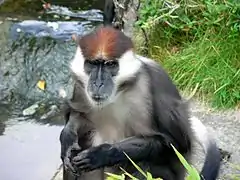| Cercocebus | |||
| É. Geoffroy Saint-Hilaire, 1812[1] | |||
 Przedstawiciel rodzaju – mangaba obrożna (C. torquatus) | |||
| Systematyka | |||
| Domena | |||
|---|---|---|---|
| Królestwo | |||
| Typ | |||
| Podtyp | |||
| Gromada | |||
| Podgromada | |||
| Infragromada | |||
| Rząd | |||
| Podrząd | |||
| Nadrodzina | |||
| Rodzina | |||
| Podrodzina | |||
| Plemię | |||
| Rodzaj |
mangaba | ||
| Typ nomenklatoryczny | |||
|
Cercocebus fuliginosus É. Geoffroy Saint-Hilaire, 1812 (= Simia (Cercopithecus) aethiops torquatus Kerr, 1792) | |||
| Synonimy | |||
| |||
| Gatunki | |||
| |||
Mangaba[3] (Cercocebus) – rodzaj ssaków naczelnych z podrodziny koczkodanów (Cercopithecinae) w obrębie rodziny koczkodanowatych (Cercopithecidae).
Zasięg występowania
Morfologia
Długość ciała (bez ogona) samic 42–59 cm, samców 43,6–73 cm, długość ogona samic 45–68 cm, samców 50–76 cm; masa ciała samic 3,9–8 kg, samców 7,1–12,5 kg[6][7].
Systematyka
Etymologia
Podział systematyczny
Do rodzaju należą następujące gatunki[10][7][4][3]:
- Cercocebus galeritus W. Peters, 1879 – mangaba oliwkowa
- Cercocebus agilis Milne-Edwards, 1886 – mangaba zwinna
- Cercocebus chrysogaster Lydekker, 1900 – mangaba złotobrzucha
- Cercocebus sanjei Mittermeier, 1986 – mangaba czubata
- Cercocebus atys (Audebert, 1797) – mangaba szara
- Cercocebus lunulatus (Temminck, 1853) – mangaba białokarkowa
- Cercocebus torquatus (Kerr, 1792) – mangaba obrożna
Przypisy
- ↑ É. Geoffroy Saint-Hilaire. Tableau des quadrumanes, ou des Animaux composant le premier Ordre de la Classe des Mammifères. „Annales du Muséum National d’Histoire Naturelle”. 19, s. 97, 1812. (fr.).
- ↑ W.Ch.L. Martin: A general introduction to the natural history of mammiferous animals, with a particular view of the physical history of man, and the more closely allied genera of the order Quadrumana, or monkeys. London: Wright and co., 1841, s. 508. (ang.).
- 1 2 Nazwy polskie za: W. Cichocki, A. Ważna, J. Cichocki, E. Rajska-Jurgiel, A. Jasiński & W. Bogdanowicz: Polskie nazewnictwo ssaków świata. Warszawa: Muzeum i Instytut Zoologii PAN, 2015, s. 44. ISBN 978-83-88147-15-9. (pol. • ang.).
- 1 2 C.J. Burgin, D.E. Wilson, R.A. Mittermeier, A.B. Rylands, T.E. Lacher & W. Sechrest: Illustrated Checklist of the Mammals of the World. Cz. 1: Monotremata to Rodentia. Barcelona: Lynx Edicions, 2020, s. 226. ISBN 978-84-16728-34-3. (ang.).
- ↑ D.E. Wilson & D.M. Reeder (redaktorzy): Genus Cercocebus. [w:] Mammal Species of the World. A Taxonomic and Geographic Reference (Wyd. 3) [on-line]. Johns Hopkins University Press, 2005. [dostęp 2020-11-08].
- 1 2 D. Zinner, G.H. Fickenscher, Ch. Roos, M.V. Anandam, E.L. Bennett, T.R.B. Davenport, N.J. Davies, K.M. Detwiler, A. Engelhardt, A.A. Eudey, E.L. Gadsby, C.P. Groves, A. Healy, K.P. Karanth, S. Molur, T. Nadler, M.C. Richardson, E.P. Riley, A.B. Rylands, L.K. Sheeran, N. Ting, J. Wallis, S.S. Waters & D.J. Whittaker: Family Cercopithecidae (Old World Monkeys). W: R.A. Mittermeier, A.B. Rylands & D.E. Wilson (redaktorzy): Handbook of the Mammals of the World. Cz. 3: Primates. Barcelona: Lynx Edicions, 2013, s. 651–654. ISBN 978-84-96553-89-7. (ang.).
- 1 2 Class Mammalia. W: Lynx Nature Books: All the Mammals of the World. Barcelona: Lynx Edicions, 2023, s. 147. ISBN 978-84-16728-66-4. (ang.).
- ↑ Palmer 1904 ↓, s. 171.
- ↑ Palmer 1904 ↓, s. 82.
- ↑ N. Upham, C. Burgin, J. Widness, M. Becker, C. Parker, S. Liphardt, I. Rochon & D. Huckaby: Treeview of Mammalian Taxonomy Hierarchy. [w:] ASM Mammal Diversity Database (Version 1.11) [on-line]. American Society of Mammalogists. [dostęp 2023-09-19]. (ang.).
Bibliografia
- T.S. Palmer. Index Generum Mammalium: a List of the Genera and Families of Mammals. „North American Fauna”. 23, s. 1–984, 1904. (ang.).
- Edmund C. Jaeger, Source-book of biological names and terms, wyd. 1, Springfield: Charles C. Thomas, 1944, s. 1-256, OCLC 637083062 (ang.).
This article is issued from Wikipedia. The text is licensed under Creative Commons - Attribution - Sharealike. Additional terms may apply for the media files.